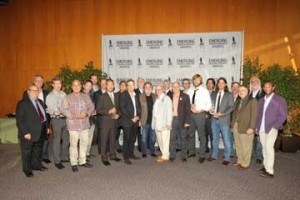
It was Carmaggedon Sunday in L.A., but the apocalyptically-themed event seemed to have gone well enough, in terms of potential gridlock, that a full house of people made it to the Directors Guild on the evening of the 30th, for the 16th Annual Emerging Cinematographers Awards.
While the title of the awards might infer these are for “student” camera-folk, in fact the awards are for members of the sponsoring International Cinematographers Guild (IA Local 600) who have simply not been designated as full-fledged directors of photography, even though they’re already working as camera operators, 1st ACs, etc. Indeed, in an aspect revelatory of how much work it takes to become a DP, some of these 600 members were themselves previous winners of “ECA’s,” and still looking for their final, career-transforming breaks.
Which tells you how high the work in 600 must be pitched, since the work on display was so good. Picking from more than 100 submissions, 10 short films were picked to be screened, all with a rather wide palette in terms of light intensity, color use, use of shadows (or not), etc.
Much of which reflected the range of equipment available – or not – for a lot of these budget-compressed shoots, whether on film stock or pixels.
In his opening remarks, director Werner Herzog noted that while these emerging DPs would go on to use a range of equipment in shooting films – though the age they were entering would be digital – it was important for cinematographers to work “in conspiracy” with their directors, to keep the set flowing. Herzog said he liked to work with his DPs “as if we had only one single shot” for the scene, in terms of camera placement. He then admonished them to “avoid cliches” (he avoided the old joke, “avoid cliches like the plague”), and to similarly “avoid endless coverage,” which he accused of being partly responsible for chewing up budgets and production schedules.
The work on display was, in the main, mostly devoid of visual cliches. It was interesting to note, however, that while work was judged solely on its cinematography, some of the more successful examples came in films that managed to pull off at least some kind of character or story arc in their short running times, or to create a fully realized mood.
Among the highlights were the “combat newsreel” look of Daron Keet’s work on the Afghani-set Ripple Effect, James Takata’s capturing of inner and outer angst on Only Child, Brian O’Carroll’s gritty greens-and-urban greys in Angel and Pete Villani’s assured studio-like work in the superheroes-in-unlikely-places tale Carjack.
The event sponsors were very generous, with Canon USA giving each one of them a C300 camera to use for six months, and the other finalists winning helpful swag and equipment, including multi-week camera packages from the likes of Panavision and Arri, a two-week rental package from Alexa, and more.
There was a reception in the DGA lobby afterwards, though clearly, with that much available talent, and free camera packages at their disposal, it would behoove any emerging writer/directors who want to team up, to befriend these emerging cinematographers immediately.





